Katharine C. Parsons,
Coastal Waterbird Program, Mass Audubon, Lincoln, Massachusetts
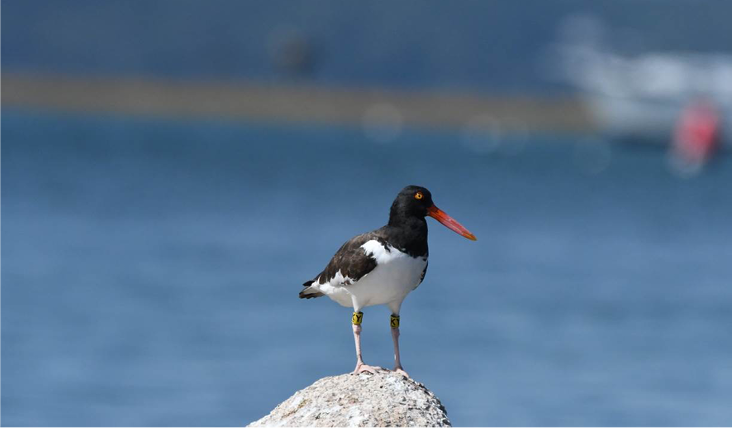
American Oystercatcher. Photograph by Lauren Miller-Donnelly.
Introduction
The American Oystercatcher (Haematopus palliatus palliatus) is a regular summer presence on a number of beaches, marshes, and islands along the coast where it nests and forages. It is a charmingly clownish shorebird with bright plumage and a relatively large size atypical of most shorebirds. Its large, emphatically orange bill is a trademark of the species. Often seen in pairs or small groups, it has a loud, heralding call and exaggerated courtship behaviors. When disturbed during incubation, it readily concedes the nest site and vanishes to a distant location to quietly wait out the threat.
American Oystercatchers are long-lived, migratory shorebirds. The Atlantic Coast subspecies breeds from Maine to Florida and winters from New Jersey south to Florida (Working Group et al. 2020). American Oystercatcher is one of only a few shorebird species that nest in temperate latitudes in the eastern United States and are thus, as ground nesters, vulnerable to human disturbance and predators along the heavily developed Atlantic coastline. The state population has been recovering over the past five decades and is currently stable, although not numerous. The opportunity to spot oystercatchers and observe their antics is a special summertime treat.
Information about American Oystercatchers in Massachusetts is available due to the dedicated and concerted efforts of many shorebird conservationists who monitor and protect nesting sites and provide data annually to MassWildlife’s Natural Heritage & Endangered Species Program (see below). The purpose of this paper is to summarize information on the status, ecology, and conservation of American Oystercatchers in the state.
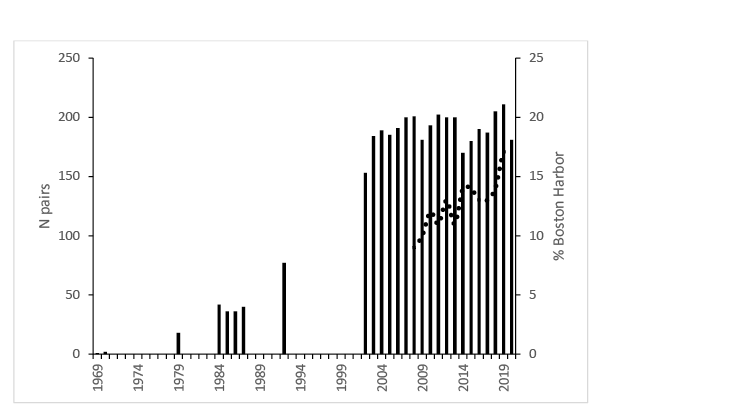
Figure 1. Abundance of nesting American Oystercatcher in Massachusetts, 1969-2020 (bars) and percentage of population nesting in Boston Harbor (●; MADFW 2016-2020; 2012-2020 data are preliminary).
Status
The conservation status of American Oystercatcher globally is ranked Least Concern with a stable population trend (BirdLife International 2016). In the United States, the U.S. Fish and Wildlife Service has identified the American Oystercatcher as a Focal Species and a Species of Conservation Concern (USFWS 2011). In Massachusetts, it is ranked as a Regional Species of Greatest Conservation Need (S2B—imperiled due to low abundance, restricted range, declines, or other factors), and of very high conservation concern (MADFW 2015). Mass Audubon’s State of the Birds, which analyzed population trends three times between the first and second state breeding bird atlases, reported a strong recent population increase and high climate vulnerability (Petersen and Meservey 2003; Walsh and Petersen 2013; Walsh and Servison 2017).
Although the record is incomplete, ornithologists think the breeding distribution of American Oystercatcher was significantly more extensive in the early nineteenth century than currently, possibly extending through the maritime provinces of Canada (Walsh and Petersen 2013). Range contraction occurred due to egging and market hunting. After extirpation from Massachusetts in the early 1800s, breeding American Oystercatchers reappeared in 1969, when a single pair was discovered nesting on Nantucket (MADFW 2015). Over the 1970s–1990s, the population increased to nearly 200 pairs (approximately 100 sites), where it has remained relatively stable for the past two decades (Figure 1).
During each of the past five years, approximately 25% of the state’s oystercatchers have nested on Nantucket, 20% on Martha’s Vineyard, 15% on the Bristol County coast of Buzzards Bay, and 16% in Boston Harbor (MADFW 2016–2020). Similar to total abundance, distribution of nesting has been relatively stable with the exception of Boston Harbor, where nesting has increased by 125% since 2006 (Figure 1). The most important areas of the state for nesting American Oystercatcher, numerous small islands in Buzzards Bay and Boston Harbor and a depauperate predator community on the large islands of Martha’s Vineyard and Nantucket, are characterized by relative isolation from ground predators.
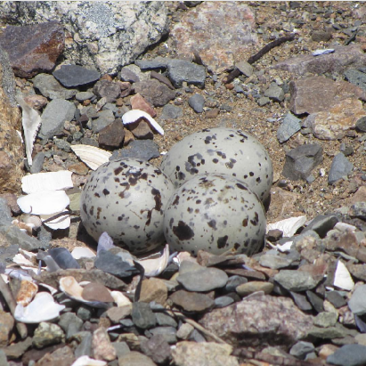
American Oystercatcher eggs. Photograph by Beth Howard.
Ecology
American Oystercatchers migrate from wintering grounds to breeding sites in Massachusetts during February and March. They are known to be highly site faithful and return to prior years’ breeding locations (Working Group et al. 2020). During April through July, oystercatchers are engaged in nesting and brood-rearing activities. The adults and juveniles begin to gather at staging locations in August and September in preparation for migration and typically have left New England by late September (Petersen and Meservey 2003).
Mass Audubon’s Coastal Waterbird Program has monitored and protected American Oystercatchers for 25 years. Shorebird biologists annually have documented nesting abundance, distribution, and productivity according to a standardized protocol (Melvin 2012) for 25%–35% of the pairs nesting in the state. Of 31 sites with active oystercatcher nesting monitored by Mass Audubon in 2019, 68% were on small islands, 22% were on relatively remote barrier beaches, and 10% were on elevated areas within extensive salt marsh.
American Oystercatchers begin arriving at Massachusetts breeding sites in mid-March, and earliest nesters are typically incubating eggs by the third week of April. The earliest hatching date recorded in 2019 was May 20 (43 pairs monitored by Mass Audubon); in 2020, the earliest date was May 13 (58 pairs). Oystercatchers that fail to hatch their first clutch are likely to relay once and possibly a second time. The latest hatch dates recorded in 2019 and 2020 were July 24 and July 14, respectively.
American Oystercatchers are known to lay a clutch of one to four eggs over a three-to six-day period and begin incubation after the second egg is laid (Working Group et al. 2020). Eggs are incubated by both male and female for 27 days, and hatching occurs over a two-to-five-day period. Young birds are fed by their parents for approximately two months after hatching, and young also begin foraging on their own at approximately two weeks post-hatch. They typically attain the capacity for sustained flight at five to seven weeks after hatching (Working Group et al. 2020).
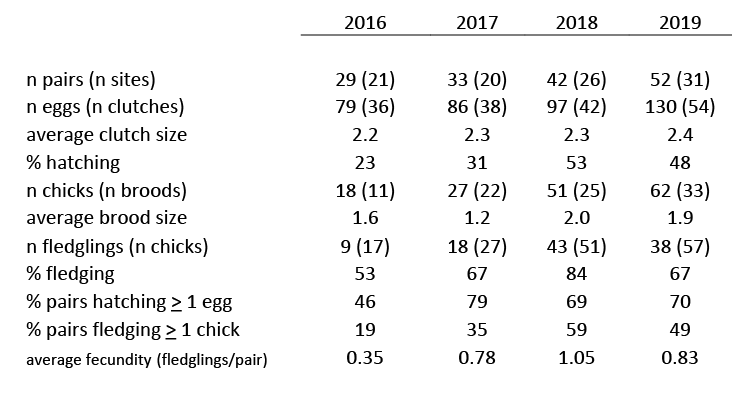
Table 1. Reproductive performance of American Oystercatcher at nesting sites monitored by Mass Audubon Coastal Waterbird Program, 2016-2019.
During 2016–2019, the clutch size of oystercatcher pairs monitored by Mass Audubon averaged 2.3 eggs (174 clutches; Table 1). The percentage of eggs hatching ranged from 23% to 53% and brood size ranged from 1.2 to 2.0 chicks. Fledging success ranged from 53% to 84% and was the strongest predictor of fecundity rate, which ranged from 0.35 to 1.05 over the four-year period (Table 1). In most of the past five years, fledging success documented in Boston Harbor was the highest of any region in the state (MADFW 2016–2020).
Relatively large post-breeding assemblages of American Oystercatcher have been documented at Monomoy and South Beach in Chatham (MADFW 2015). These locations with extensive mud flats, salt marshes, and natural inlets presumably provide oystercatchers with enhanced foraging opportunities as they prepare for migration.
Conservation
The primary threats to successful breeding by American Oystercatchers are egg and chick predators, and nest overwash. The cause of egg loss was not determined in a significant proportion of failed clutches in pairs monitored by Mass Audubon in 2016–2019 (Table 2); however, of those lost clutches where the causal factor was known, predation was the most important determining cause. In addition, it is likely that many of the lost eggs that could not be attributed to a known factor were taken by predators. Loss of clutches due to overwash was also significant in most years. In all years except 2018, the canid predators eastern coyote (Canis latrans x Canis lycaon) and red fox (Vulpes vulpes) were responsible for most eggs lost due to predation. In 2018, avian predators such as American Crow (Corvus brachyrhynchos) and gull species (Larus spp.) were responsible for most egg loss.

Figure 2. Population growth of nesting Piping Plover (●) and American Oystercatcher (■) in Massachusetts, 1984-2000 (MADFW 2020; plover 2018-2020 and oystercatcher 2012-2020 data are preliminary).
Losses attributed to human disturbance are relatively rare in pairs monitored by Mass Audubon. Shorebird conservationists throughout the state implement a standardized protocol for protection and monitoring that includes the installation of symbolic fencing of nesting habitat (posts, twine, and signs) or use of oystercatcher-specific signage. Additionally, because American Oystercatchers preferentially nest on islands and on elevated sites within salt marshes, their eggs and chicks are relatively isolated from human disturbance.
In nesting areas shared with Piping Plovers (Charadrius melodus), it is likely that American Oystercatcher has benefited from conservation efforts for plovers. The Piping Plover was listed under federal and state endangered species laws in the mid-1980s; the increase in plover numbers over the next decade coincides with population growth of oystercatchers (Figure 2). However, as Piping Plovers have continued to increase in the state by exploiting marginal nesting habitat on hundreds of beaches, American Oystercatcher has apparently reached carrying capacity, and it is likely that the availability of island nesting sites is limiting further population growth.
Reliance on small islands and salt marshes for nesting sites makes American Oystercatcher one of the coastal bird species most vulnerable to the impacts of climate change (Walsh and Servison 2017; Working Group et al. 2020). Clutches lost to overwash as a result of storms and extreme tidal events accounted for an average 25% of egg failure at sites monitored by Mass Audubon in 2016–2020. Although subject to random occurrence and variable timing, the overall rate of clutches lost to overwash increased significantly over the past five years (Table 2).
Management recommendations for successful conservation of American Oystercatcher include continued nesting site protection and monitoring according to the standardized protocol currently in use (Melvin 2012). In addition, reducing trash on beaches that could attract predators, providing effective signage for kayakers accessing islands, and prohibiting dogs from nesting and foraging habitat are essential objectives for successful management. Outreach to the beachgoing public is a proven strategy for effective protection of beach nesting birds in the state.

Table 2. Factors of egg loss of American Oystercatcher at nesting sites monitored by Mass Audubon Coastal Waterbird Program, 2016-2020. Numbers represent percent of all clutches laid (n clutches= 36 in 2016, 38 in 2017, 42 in 2018, 54 in 2019, 28 in 2020).
State-wide data management and timely analysis are constrained by the lack of a system to streamline data submission to MassWildlife similar to online tools available for plovers and terns. A state-wide analysis of nesting site jeopardy due to climate change impacts would allow shorebird conservationists to pursue options for enhanced habitat protection and replacement.
Fostering the continued engagement of the dozens of organizations and individuals providing on-the-ground protection of American Oystercatchers throughout the state is of the highest priority. In particular, Shiloh Schulte (Manomet Center for Conservation Sciences), Karen Beattie (Nantucket Conservation Foundation), Luanne Johnson (BiodiversityWorks), Carol Trocki (Mosaic Land Management, LLC; Boston Harbor Islands National and State Park), and Carolyn Mostello (Massachusetts Division of Fisheries and Wildlife) have long championed the success of oystercatchers in Massachusetts. Support for these organizations as well as efforts by the Cape Cod National Seashore, Monomoy National Wildlife Refuge, The Trustees of Reservations, and Tuckernuck Land Trust is key to maintaining a robust population of American Oystercatchers in the state and planning for their success in the future.
Acknowledgments
Mass Audubon is grateful for the sustaining support for American Oystercatcher conservation we have received from the National Fish and Wildlife Foundation, the Island Foundation, the U.S. Fish and Wildlife Service, and private donors. In addition, the Massachusetts Department of Conservation and Recreation and Massachusetts Division of Fisheries and Wildlife have provided partial support of our work to protect oystercatchers in Boston Harbor and on Cape Cod. I am grateful to Gislaine Peters, who compiled much of Mass Audubon’s data for this paper, and to the hundreds of Coastal Waterbird Program shorebird monitors who have helped achieve the conservation success of American Oystercatchers in Massachusetts.
Literature Cited
- BirdLife International. 2016. Haematopus palliatus. The IUCN Red List of Threatened Species https://dx.doi.org/10.2305/IUCN.UK.2016-3.RLTS.T22693644A93416407.en. Accessed April 25, 2021.
- MADFW (Massachusetts Division of Fisheries and Wildlife). 2015. Massachusetts State Wildlife Action Plan 2015. Westborough, Massachusetts: Massachusetts Division of Fisheries and Wildlife. https://www.mass.gov/files/documents/2016/12/wh/ma-swap-public-draft-26june2015-chapter3.pdf. Accessed April 5, 2021.
- MADFW (Massachusetts Division of Fisheries and Wildlife). 2016–2020. Annual census data compiled by Natural Heritage & Endangered Species Program. Westborough, Massachusetts: Massachusetts Division of Fisheries and Wildlife.
- Melvin, S. 2012. Summary of 2011 Census of American Oystercatchers in Massachusetts. Westborough, Massachusetts: Natural Heritage & Endangered Species Program, Massachusetts Division of Fisheries and Wildlife.
- Petersen, W. R. and W. R. Meservey, (eds.). 2003. Massachusetts Breeding Bird Atlas 1. Lincoln, Massachusetts: Massachusetts Audubon Society.
- Walsh, J. M. and W. R. Petersen. 2013. Massachusetts Breeding Bird Atlas 2. Lincoln, Massachusetts: Massachusetts Audubon Society, (Published by Scott and Nix).
- Walsh, J. M. and M. S. V. Servison, (eds.). 2017. State of the Birds 2017: Massachusetts Birds and Our Changing Climate. Lincoln, Massachusetts: Massachusetts Audubon Society.
- USFWS (U.S. Fish and Wildlife Service). 2011. U.S. Fish and Wildlife Service Birds of Management Concern and Focal Species. https://www.fws.gov/migratorybirds/pdf/management/BMCFocalSpecies.pdf. Accessed April 5, 2021.
- Working Group, A. O., E. Nol, and R. C. Humphrey. (2020). American Oystercatcher (Haematopus palliatus), version 1.0. In Birds of the World (A. F. Poole, Editor). Cornell Lab of Ornithology, Ithaca, NY, USA. https://doi.org/10.2173/bow.ameoys.01. Accessed April 5, 2021.
Katharine Parsons received her bachelor’s degree from Smith College and PhD in ecology from Rutgers University. She has 40 years of experience in coastal waterbird research, management, and policy in the Northeast. Since 2011, Dr. Parsons has directed Mass Audubon’s Coastal Waterbird Program, which works with coastal communities throughout Massachusetts to protect rare birds and their habitats. She is past president of the Waterbird Society. In addition, Dr. Parsons is a Lecturer at Harvard University’s Graduate School of Design, where she has taught courses in landscape ecology and currently leads a seminar, Changing Natural and Built Coastal Environments.
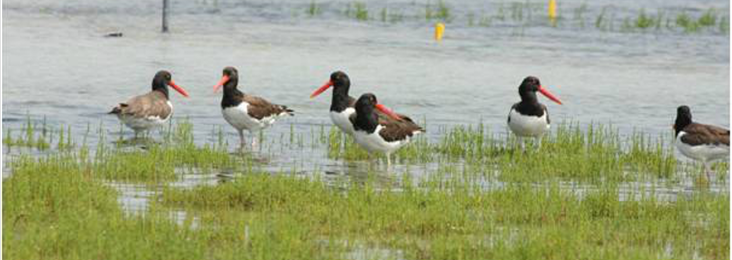
American Oystercatchers. Photograph by Ben Carroll.